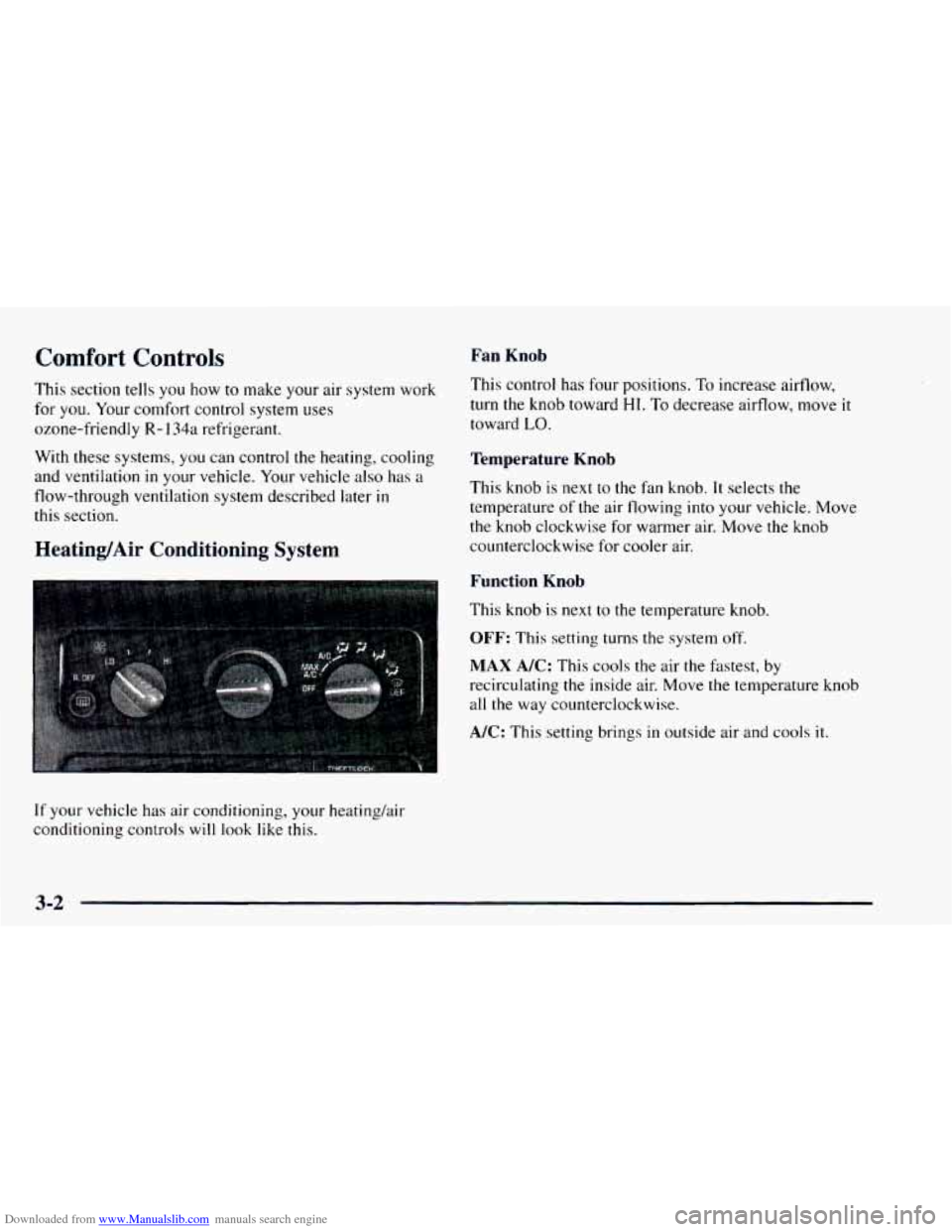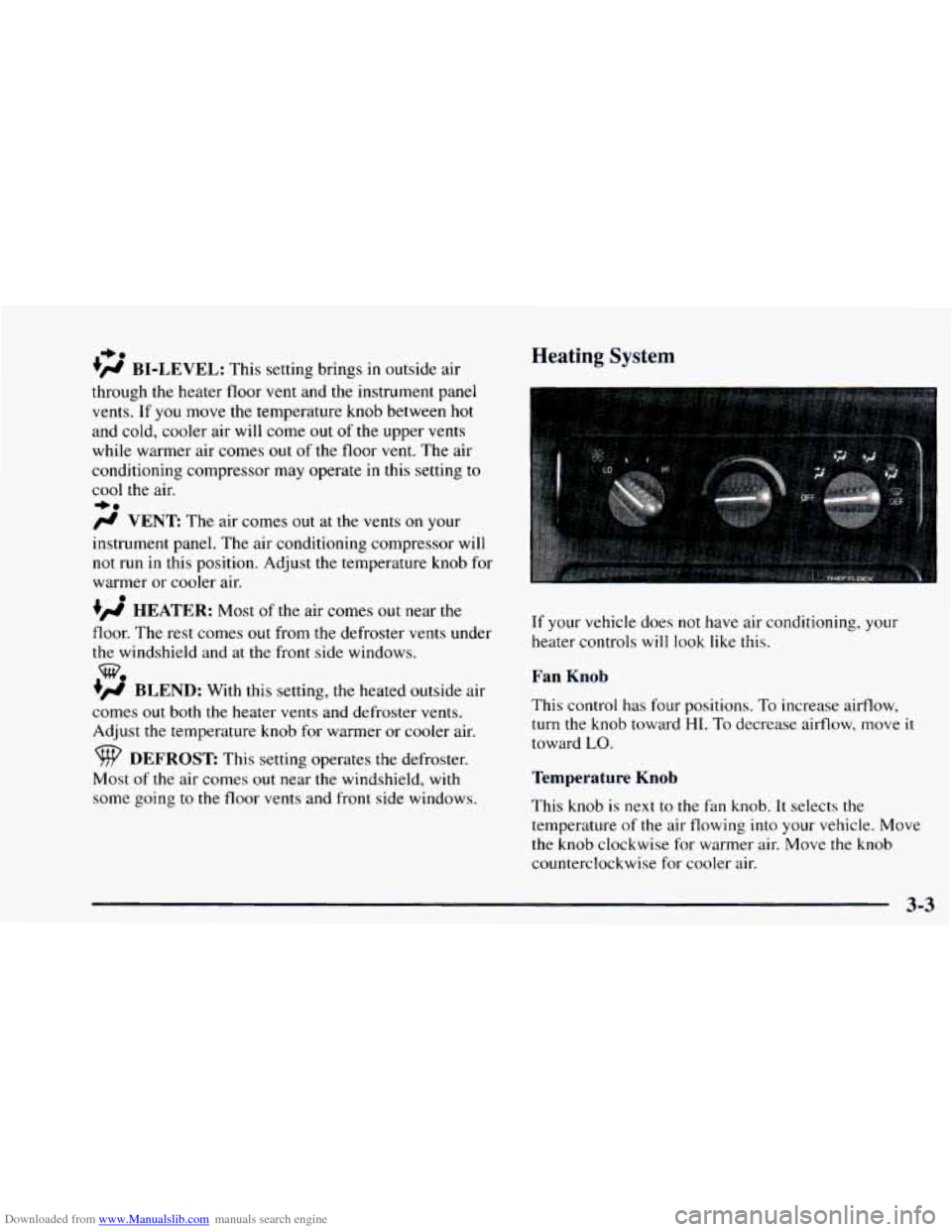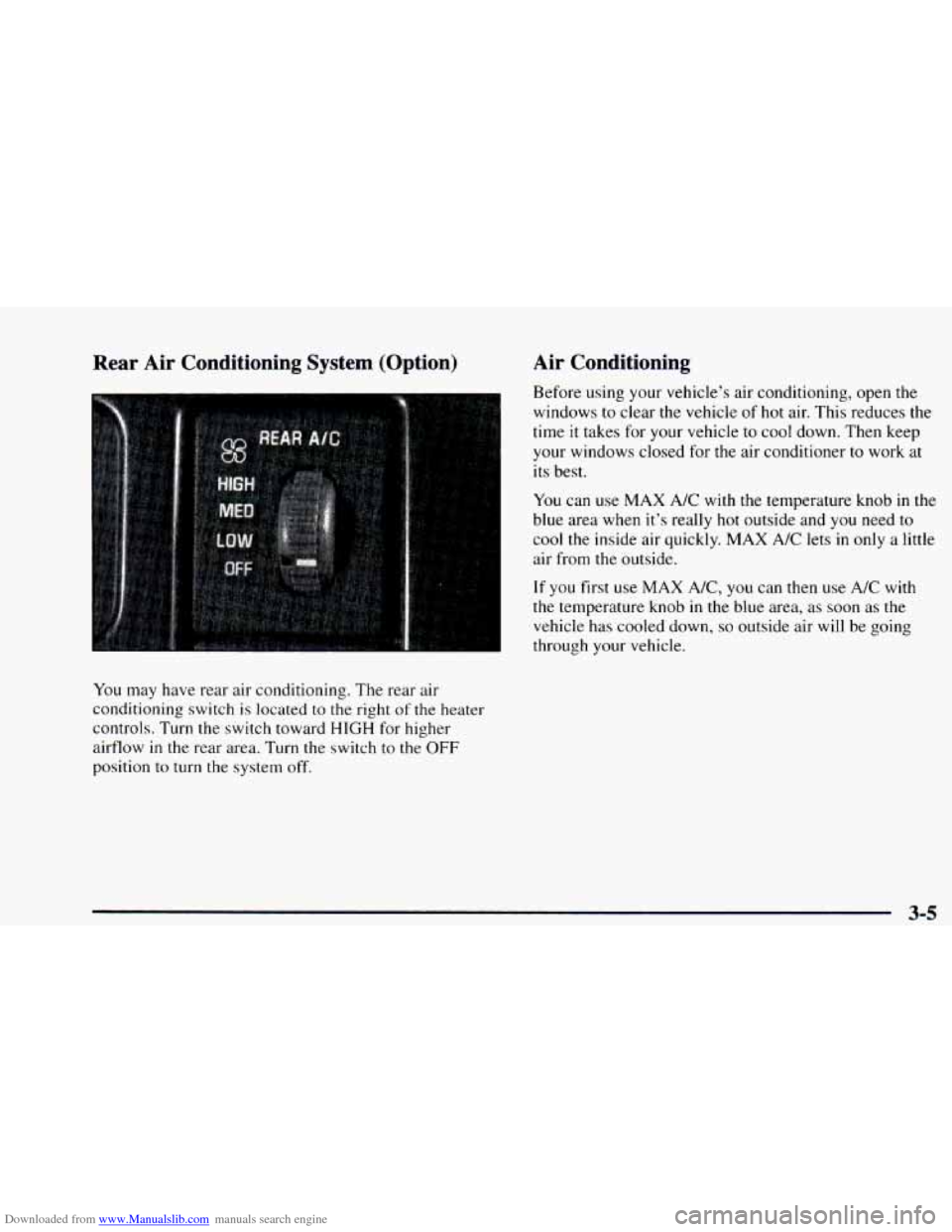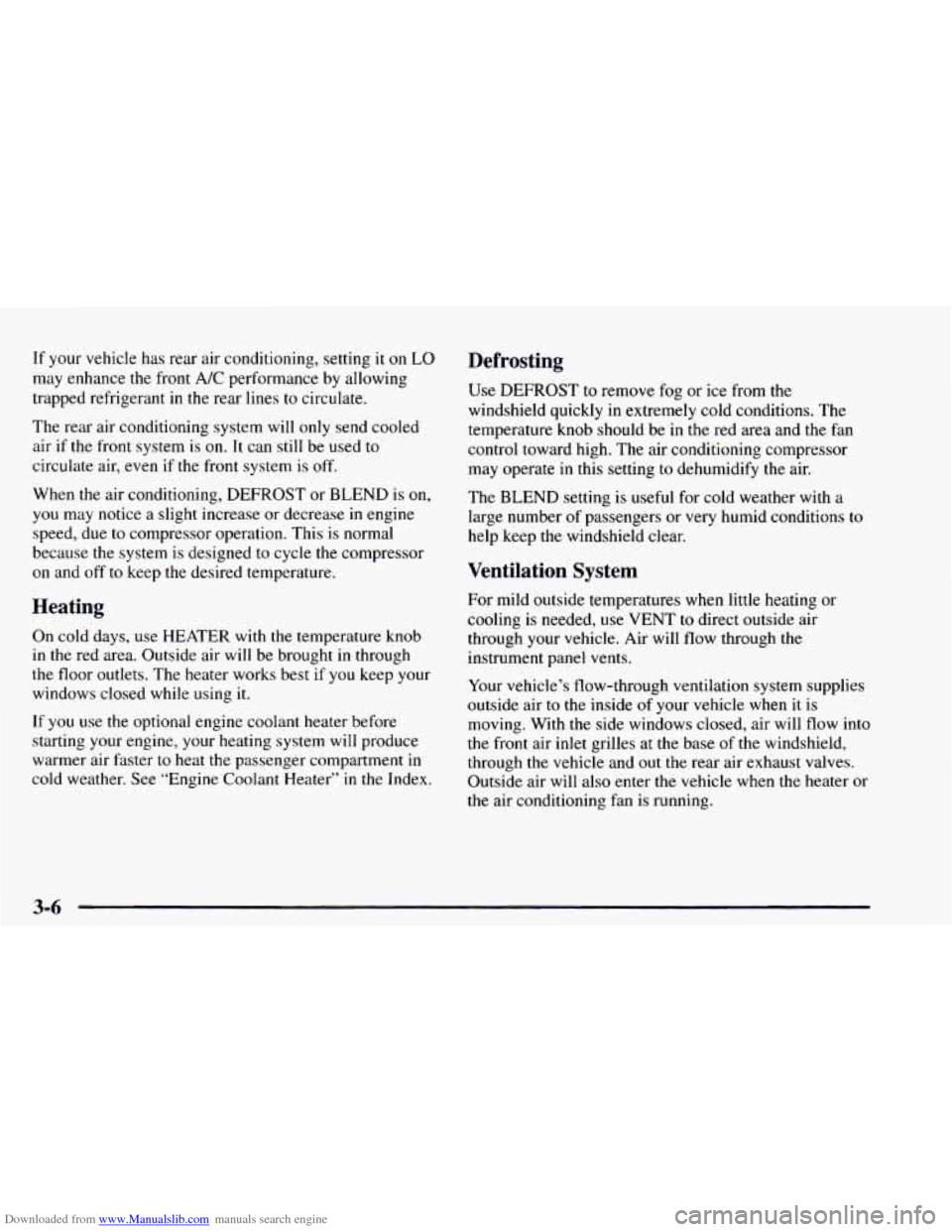1997 CHEVROLET ASTRO air condition
[x] Cancel search: air conditionPage 121 of 404

Downloaded from www.Manualslib.com manuals search engine Temperature and Compass Display
The outside air temperature and the compass are
displayed at
the front of the overhead console. The
control switches are located
to the left of the display.
Turn the display on or off by pressing the ON/OFF
switch. Display the temperature
in either degrees
Fahrenheit (English) or Celsius (metric) by pressing
the
UWMET switch. Before
you turn
on the ignition and move the vehicle,
the temperature indicated will be the last outside
temperature recorded with the ignition
on.
If the outside temperature is 37°F (3°C) or lower when
you turn
on the ignition, ICE will appear on the display.
This is a warning
to the driver that road conditions may
be icy, and that appropriate precautions should be taken.
The compass is self-calibrating,
so it does not need to
be manually set. However, when your vehicle is new,
the compass may function erratically. If it does, CAL
(Calibration) will appear
on the display. To correct the
problem, drive slowly
in a complete 360" circle three
times, and
the compass will function normally.
Variance is the difference between magnetic north and
geographic north. In some areas, the difference between
the two can be great enough to cause false compass
readings.
If this happens, follow these instructions to
set the variance for your particular location:
Page 135 of 404

Downloaded from www.Manualslib.com manuals search engine Air Bag Readiness Light
There is an air bag readiness light on the instrument
panel, which shows
AIR BAG. The system checks the
air bag’s electrical system for malfunctions. The light
tells
you if there is an electrical problem. The system
check includes the air bag sensors, the air bag modules,
the wiring and the crash sensing and diagnostic module.
For more information on the air bag system, see “Air
Bag” in the Index.
AIR
BAG
This light will come on
when you start your engine,
and it will flash for a few
seconds. Then the light
should go out. This means
the system is ready.
If the air bag readiness light stays
on after you start the
engine or comes
on when you are driving, your air bag
system may not work properly. Have your vehicle
serviced right away.
The air bag readiness light should flash for a few
seconds when
you turn the ignition key to RUN. If the light doesn’t
come
on then, have it fixed so it will be
ready to warn
you if there is a problem.
Charging System Indicator Light
The charglng system light
will come on briefly when
you turn the ignition on, but
the engine is
not running, as
a check
to show you the
light is working.
Then it should go out once the engine is running. If it
stays on, or comes
on while you are driving, you may
have a problem with the electrical charging system.
It could indicate that
you have a loose accessory drive
belt, or another electrical problem. Have it checked
right away. Driving while this light
is on could drain
your battery.
If you must drive a short distance with the light on, be
certain to turn off all your accessories, such as the radio
and heatedair conditioner.
Page 139 of 404

Downloaded from www.Manualslib.com manuals search engine Malfunction Indicator Lamp (Service Engine Soon Light)
Your vehicle is equipped
with a computer which
monitors operation of the
fuel, ignition and emission SERVICE
ENGINE
SOON
This system is called OBD I1 (On-Board
Diagnostics-Second Generation) and is intended to
assure that emissions are at acceptable levels for the life
of the vehicle, helping
to produce a cleaner
environment. (In Canada, OBD
I1 is replaced by
Enhanced Diagnostics.) The SERVICE ENGINE SOON
light comes
on to indicate that there is a problem and
service is required. Malfunctions
often will be indicated
by the system before any problem is apparent. This may
prevent more serious damage to your vehicle. This
system is also designed
to assist your service technician
in correctly diagnosing any malfunction.
NOTICE:
If you keep driving your vehicle with this light
on, after a while, your emission controls may not
work as well, your fuel economy may not be
as
good and your engine may not run as smoothly.
This could lead to costly repairs that may not be
covered by your warranty.
This light should come on, as a check to show you it is
working, when the ignition is on and the engine is not
running. If the light doesn’t come on, have it repaired.
This light will also come
on during a malfunction in one
of two ways:
0
0
Light Flashing -- A misfire condition has been
detected.
A misfire increases vehicle emissions and
may damage the emission control system on your
vehicle. Dealer or qualified service center diagnosis
and service is required.
Light On Steady -- An emission control system
malfunction has been detected on your vehicle.
Dealer or qualified service center diagnosis and
service may be required.
2-65
Page 147 of 404

Downloaded from www.Manualslib.com manuals search engine Section 3 Comfort Controls and Audio Systems
In this section, you’ll find out how to operate the comfort control and audio systems offered with your vehicle. Be
sure to read about
the particular systems supplied with your vehicle.
3-2 3-2
3-3 3
-4
3 -5
3-5
3-6
3-6
3-6 3-8
3-9
3-9
3-9
3 -9 Comfort Controls
Heating/Air Conditioning System
Heating System
Rear Heating System (Option) Rear Air Conditioning System (Option)
Air Conditioning
Heating
Defrosting
Ventilation System
Rear Window Defogger (Option)
Audio Systems
Setting the Clock for Systems without
Automatic Tone Control
Setting the Clock for Systems
with
Automatic Tone Control
AM-FM Stereo 3-1
1
3-13
3-18
3-19
3-24
3-26
3-28
3-28
3-29
3-30
3-30
AM-FM Stereo with Cassette Tape
Player
(If Equipped)
AM-FM Stereo with Cassette Tape and
Automatic Tone Control
(If Equipped)
Rear Seat Audio
(If Equipped)
AM-FM Stereo
with Compact Disc Player and
Automatic Tone Control (If Equipped)
Playing a Compact Disc
in the Single Remote
Disc Player
(If Equipped)
Theft-Deterrent Feature Understanding Radio Reception
Tips About Your Audio System
Care
of Your Cassette Tape Player
Care
of Your Compact Discs
Fixed Mast Antenna
3-1
Page 148 of 404

Downloaded from www.Manualslib.com manuals search engine Comfort Controls
This section tells you how to make your air system work
for you. Your comfort control system uses
ozone-friendly
R- 134a refrigerant.
With these systems, you can control the heating, cooling
and ventilation
in your vehicle. Your vehicle also has a
flow-through ventilation system described later
in
this section.
Heating/Air Conditioning System
If your vehicle has air conditioning, your heatinghir
conditioning controls will
look like this.
Fan Knob
This control has four positions. To increase airflow,
turn the knob toward
HI. To decrease airflow, move it
toward LO.
Temperature Knob
This knob is next to the fan knob. It selects the
temperature
of the air flowing into your vehicle. Move
the knob clockwise for warmer air. Move the knob
counterclockwise for cooler air.
Function Knob
This knob is next to the temperature knob.
OFF: This setting turns the system off.
MAX A/C: This cools the air the fastest, by
recirculating the inside air. Move the temperature knob
all the way counterclockwise.
A/C: This setting brings in outside air and cools it.
3-2
Page 149 of 404

Downloaded from www.Manualslib.com manuals search engine +.
+# BI-LEVEL: This setting brings in outside air Heating System
through the heater floor vent and the instrument panel
vents. If
you move the temperature knob between hot
and cold, cooler air will come out of the upper vents
while warmer air comes out
of the floor vent. The air
conditioning compressor may operate in this setting
to
cool the air.
+e
/J VENT: The air comes out at the vents on your
instrument panel. The air conditioning compressor will
not run in this position. Adjust the temperature knob for
warmer or cooler air.
+’ HEATER: Most of the air comes out near the
floor. The rest comes
out from the defroster vents under
the windshield and at the front side windows.
we
+’ BLEND: With this setting, the heated outside air
comes out both
the heater vents and defroster vents.
Adjust the temperature knob for warmer or cooler air.
0
DEFROST This setting operates the defroster.
Most
of the air comes out near the windshield, with
some going to the floor vents and front side windows.
If your vehicle does not have air conditioning, your
heater controls will
look like this.
Fan Knob
This control has four positions. To increase airflow,
turn the knob toward
HI. To decrease airflow, move it
toward LO.
Temperature Knob
This knob is next to the fan knob. It selects the
temperature of the air flowing into your vehicle. Move
the knob clockwise for warmer air. Move the knob
counterclockwise
for cooler air.
3-3
Page 151 of 404

Downloaded from www.Manualslib.com manuals search engine Rear Air Conditioning System (Option)
You may have rear air conditioning. The rear air
conditioning switch
is located to the right of the heater
controls. Turn the switch toward
HIGH for higher
airflow
in the rear area. Turn the switch to the OFF
position to turn the system off.
Air Conditioning
Before using your vehicle’s air conditioning, open the
windows to clear the vehicle
of hot air. This reduces the
time
it takes for your vehicle to cool down. Then keep
your windows closed for the air conditioner to work at
its best.
You can use MAX A/C with
the temperature knob in the
blue area when it’s really hot outside and you need to
cool the inside air quickly. MAX A/C lets
in only a little
air from the outside.
If you first use MAX A/C, you can then use A/C with
the temperature knob in the blue area, as soon as the
vehicle has cooled down, so outside air will be going
through your vehicle.
3-5
Page 152 of 404

Downloaded from www.Manualslib.com manuals search engine If your vehicle has rear air conditioning, setting it on LO
may enhance the front A/C performance by allowing
trapped refrigerant
in the rear lines to circulate.
The rear air conditioning system will
only send cooled
air
if the front system is on. It can still be used to
circulate air, even if the front system
is off.
When the air conditioning, DEFROST or BLEND is on,
you may notice a slight increase or decrease in engine
speed, due to compressor operation. This
is normal
because the system is designed to cycle the compressor
on and off to keep the desired temperature.
Heating
On cold days, use HEATER with the temperature knob
in the red area. Outside air will be brought in through
the floor outlets. The heater works best if you keep your
windows closed while using it.
If you use the optional engine coolant heater before
starting your engine, your heating system will produce
warmer air faster
to heat the passenger compartment in
cold weather. See “Engine Coolant Heater” in the Index.
Defrosting
Use DEFROST to remove fog or ice from the
windshield quickly in extremely cold conditions. The
temperature knob should be in the red area and the fan
control toward high. The air conditioning compressor
may operate in this setting to dehumidify the air.
The
BLEND setting is useful for cold weather with a
large number of passengers or very humid conditions to
help keep the windshield clear.
Ventilation System
For mild outside temperatures when little heating or
cooling is needed, use VENT to direct outside air
through your vehicle. Air will flow through the
instrument panel vents.
Your vehicle’s flow-through ventilation system supplies
outside air to the inside
of your vehicle when it is
moving. With the side windows closed, air will flow into
the front air inlet grilles at the base
of the windshield,
through
the vehicle and out the rear air exhaust valves.
Outside air will also enter the vehicle when the heater or
the air conditioning fan is running.